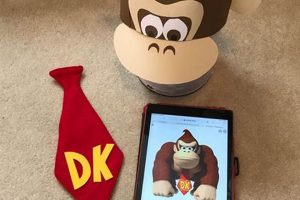A self-assembled representation of a construction worker, typically for celebratory or theatrical purposes, often includes components such as a hard hat, safety vest, toy tools, and work boots. The objective is to visually emulate the attire and accessories associated with individuals employed in the construction industry.
The creation of such a representation offers a cost-effective alternative to purchasing pre-made costumes. It allows for personalization and adaptation to specific size requirements, and can incorporate readily available household items. Furthermore, engaging in the assembly process can foster creativity and resourcefulness, particularly when involving children in the project. Historically, homemade costumes have served as a budget-friendly option for celebratory events and theatrical productions, representing various professions and characters.
The following sections will detail the essential elements of this project, provide step-by-step guidance on assembly, and offer suggestions for customization and safety considerations.
Tips for Crafting a Cost-Effective Construction Worker Representation
Constructing a convincing and budget-conscious representation of a construction worker requires careful planning and resourcefulness. The following tips offer guidance on creating an effective and safe representation without incurring significant expense.
Tip 1: Prioritize Safety Headgear: A hard hat is essential. If a genuine hard hat is unavailable, a sturdy plastic bowl or helmet can serve as a substitute. Ensure it is appropriately sized and securely fastened to prevent accidental dislodging.
Tip 2: Utilize High-Visibility Materials: A safety vest, typically orange or yellow, enhances the visual representation. If a vest is unavailable, affix reflective tape to a plain shirt or jacket to mimic the appearance of a high-visibility garment.
Tip 3: Employ Cardboard for Tool Replicas: Constructing mock tools from cardboard is a cost-effective alternative to purchasing plastic tools. A cardboard hammer, wrench, or saw can contribute to the overall impression. Ensure edges are smoothed to prevent injury.
Tip 4: Adapt Existing Footwear: Avoid purchasing new boots. Existing work boots or sturdy shoes can suffice. Consider applying shoe polish or dirt to enhance their rugged appearance.
Tip 5: Accessorize with Practical Items: A tool belt, even if empty, adds authenticity. A repurposed belt with attached pouches can serve this purpose. Alternatively, pockets can be sewn onto existing clothing to simulate a tool belt.
Tip 6: Focus on Durable Fabrics: Opt for clothing made from durable fabrics, such as denim or canvas, to withstand wear and tear during use. These materials contribute to the impression of workwear.
Tip 7: Consider Weather Conditions: Adapt the ensemble to the prevailing weather. In colder conditions, incorporate a jacket, gloves, and a knit hat. In warmer weather, opt for lighter clothing and a bandanna for head protection.
The effective creation of a convincing construction worker representation relies on resourcefulness, attention to detail, and a commitment to safety. By employing readily available materials and adhering to these tips, a compelling and cost-effective ensemble can be achieved.
The subsequent sections will provide more comprehensive guidelines on adapting and customizing the construction worker representation for varied purposes and age groups.
1. Safety Headgear
Safety headgear forms a crucial component of any credible construction worker representation. Its inclusion serves not only to enhance visual authenticity but also to underscore the importance of workplace safety. The selection and adaptation of headgear, whether a genuine hard hat or a simulated alternative, merits careful consideration.
- Authenticity of Appearance
The presence of a hard hat significantly contributes to the overall realism of the representation. Its distinct shape and color immediately associate the wearer with the construction profession. A genuine hard hat offers the most authentic visual, while a suitable substitute, such as a reinforced plastic bowl, can achieve a similar effect. The color should ideally be bright and easily visible, conforming to standard construction site safety regulations.
- Symbolic Significance
Beyond its visual impact, safety headgear carries symbolic weight. It represents the protective measures employed in hazardous work environments. Including this element serves as a reminder of the potential dangers inherent in construction work. This symbolic significance can be particularly impactful when the representation is intended for educational purposes, highlighting the importance of safety protocols.
- Adaptation for Safety
While a genuine hard hat provides impact protection, simulated headgear typically lacks this feature. Therefore, careful consideration must be given to the material and construction of the substitute. Sharp edges should be avoided, and the headgear should be securely fastened to prevent accidental dislodging. The primary objective is to avoid creating a potential hazard while maintaining the visual impression of safety headgear.
- Sizing and Comfort
Regardless of whether a genuine or simulated hard hat is used, proper sizing and comfort are essential. Headgear that is too large can obstruct vision and increase the risk of falling off, while headgear that is too small can be uncomfortable and restrict movement. Adjustable straps or padding can be used to achieve a secure and comfortable fit, particularly for children.
The integration of safety headgear into a construction worker representation extends beyond mere aesthetics. It serves as a visual cue, a symbolic reminder of workplace safety, and a practical consideration for the wearer’s well-being. A well-chosen and properly adapted hard hat significantly enhances the overall effectiveness of the representation while simultaneously promoting a safety-conscious message.
2. Visible Vest
A high-visibility vest constitutes a critical element within a self-assembled construction worker representation. Its presence significantly enhances the realism and accuracy of the portrayal. The cause-and-effect relationship is direct: the inclusion of a visible vest immediately evokes the visual identity associated with construction personnel. Its absence diminishes the authenticity of the representation, potentially undermining the intended effect. For instance, a person dressed in work clothes and a hard hat, but lacking a visible vest, may be mistaken for a mechanic or factory worker, highlighting the vest’s defining role.
The importance of the visible vest extends beyond mere aesthetics. In
real-world construction environments, high-visibility garments serve a crucial safety function, enhancing the wearer’s visibility to prevent accidents. Emulating this aspect in a self-assembled representation provides an opportunity to subtly reinforce the significance of safety protocols. A child donning such a representation, for example, might become more aware of the importance of being seen in potentially hazardous environments. Practical application lies in utilizing bright, fluorescent materials, often coupled with reflective strips, to mimic the appearance of genuine safety vests. Readily available and inexpensive fabrics or repurposed items, such as safety-orange garbage bags carefully cut and modified, can serve as effective substitutes.
In summary, the visible vest is not merely an accessory but an integral component of a compelling construction worker representation. Its presence creates a visual shorthand for the profession while subtly promoting safety awareness. Challenges may arise in sourcing appropriate materials or adapting existing garments, but the resulting increase in authenticity and the potential educational benefits justify the effort. Its significance links to the broader theme of accurately and responsibly portraying professions, contributing to a more informed and respectful understanding of various occupations.
3. Imitation Tools
Imitation tools represent a crucial element in the composition of a self-assembled construction worker representation. The inclusion of such tools, albeit non-functional, significantly enhances the verisimilitude of the portrayal. The presence of a toy hammer, wrench, or screwdriver immediately conveys the occupational context. Conversely, the absence of tools diminishes the clarity and impact of the representation, potentially leading to ambiguity regarding the intended persona.
The practical significance of imitation tools lies in their ability to provide visual cues without posing safety risks. Real construction tools are inherently hazardous, making them unsuitable for use in a costume, particularly when children are involved. Examples of appropriate imitation tools include lightweight plastic replicas, cardboard cutouts, or inflatable versions. These alternatives offer a safe and cost-effective means of conveying the essential characteristics of the construction trade. Furthermore, the act of crafting imitation tools can serve as an educational exercise, fostering creativity and resourcefulness while simultaneously reinforcing an understanding of the tools used in construction.
The appropriate selection and utilization of imitation tools are essential for a successful self-assembled construction worker representation. The tools contribute to the overall impression and promote safety. Challenges may include finding suitable materials or adapting existing toys to resemble construction equipment. The incorporation of tools links to the broader theme of accurately representing professions while prioritizing safety and educational value.
4. Sturdy Footwear
Sturdy footwear is an essential element in a self-assembled construction worker representation. Footwear choice contributes significantly to the overall authenticity and safety of the portrayal, mirroring the functional requirements of actual construction work.
- Authenticity and Visual Cues
The selection of appropriate footwear immediately signals the wearer’s intended role. Work boots, or footwear that closely resembles them, provide a strong visual cue that connects the individual to the construction profession. Lacking appropriate footwear weakens the intended effect, potentially confusing the representation with other occupational roles. Footwear examples include hiking boots, work boots, or even durable sneakers modified to resemble work boots.
- Mimicking Functional Requirements
Real construction work demands footwear that provides protection, support, and traction. While a self-assembled representation does not require the same level of protection, simulating these functional aspects enhances realism. For example, adding cardboard or foam padding to the toes of existing shoes mimics the reinforced toe caps found in work boots. Similarly, attaching textured rubber to the soles can simulate the traction provided by work boot treads.
- Safety Considerations
While a construction worker representation prioritizes appearance over genuine protection, certain safety considerations remain relevant. Avoid footwear with loose straps or laces that could cause tripping. Ensure that the footwear is appropriately sized and provides adequate support to prevent discomfort or injury. If the representation involves physical activity, such as walking or playing, prioritize footwear that allows for safe and comfortable movement.
- Cost-Effective Alternatives
Purchasing new work boots specifically for a construction worker representation may not be practical. A cost-effective alternative involves adapting existing footwear to resemble work boots. Applying shoe polish or dirt to durable shoes can create a weathered appearance. Adding duct tape or fabric patches can simulate wear and tear, further enhancing the illusion. Focus on achieving the visual impression of sturdy, functional footwear without incurring significant expense.
The integration of sturdy footwear is essential for creating a credible and safe construction worker representation. Footwear provides a strong visual signal of the wearer’s intended role. The overall success depends on its appropriateness, realism, and safety considerations. This aspect contributes significantly to an effective and convincing representation.
5. Work Clothes
The selection and adaptation of appropriate work clothes are fundamental to constructing a convincing representation of a construction worker. The attire serves as a primary visual indicator of the profession, contributing significantly to the overall impression.
- Durability and Fabric Choice
Construction work necessitates durable clothing capable of withstanding physical strain and exposure to the elements. Materials such as denim, canvas, and heavy-duty cotton are commonly associated with work clothes due to their resilience and resistance to wear and tear. In the context of assembling a self-made representation, prioritizing fabrics with similar characteristics enhances the authenticity and conveys the practical demands of the profession. Examples include repurposing old jeans, denim jackets, or canvas overalls.
- Color Palette and Authenticity
Traditional work clothes often feature neutral or muted colors that minimize the visibility of dirt and grime. Earth tones, navy blue, and gray are frequently employed to create a practical and understated aesthetic. When selecting attire for a representation, adhering to this color palette strengthens the association with construction work and contributes to a more realistic portrayal. Incorporating faded or slightly worn clothing can further enhance the impression of authenticity.
- Fit and Functionality
Work clothes are t
ypically designed for comfort and ease of movement, allowing workers to perform physical tasks without restriction. Loose-fitting garments, such as overalls or work shirts, are often preferred for their practicality and versatility. When assembling a representation, prioritizing garments that allow for a comfortable range of motion is crucial. Avoiding overly restrictive or formal attire ensures that the representation accurately reflects the functional requirements of construction work. - Layering and Adaptability
Construction workers often employ layering techniques to adapt to varying weather conditions. Adding a flannel shirt, a denim jacket, or a vest over a basic work shirt provides insulation and protection from the elements. Incorporating layering into the attire enhances the representation’s realism and demonstrates an understanding of the practical considerations involved in construction work. The adaptation of attire for different weather conditions further contributes to the authenticity of the portrayal.
The deliberate selection and adaptation of work clothes significantly influence the success of creating a convincing construction worker representation. By focusing on durability, color palette, fit, and layering, individuals can assemble attire that accurately reflects the demands and characteristics of the profession. The effective utilization of work clothes serves as a cornerstone in achieving an authentic and impactful representation.
6. Appropriate Size
Appropriate size represents a critical factor in the effective execution of a self-assembled construction worker representation. The dimensions and fit of each component, from safety headgear to footwear, directly influence the realism, comfort, and safety of the final presentation.
- Credibility of Portrayal
The dimensions of the representation must align with the intended wearer. Overly large or small components diminish the credibility of the portrayal. A hard hat that constantly slips off or work boots that are several sizes too large create a comical, rather than authentic, impression. Achieving an accurate fit is essential for conveying the seriousness and professionalism associated with the construction trade.
- Range of Motion and Maneuverability
Construction work requires a full range of motion. Clothing and accessories that are too tight or restrictive impede movement and hinder the wearer’s ability to perform simulated tasks. Conversely, overly loose garments pose a safety hazard by potentially snagging or causing trips. Ensuring an appropriate size allows for comfortable and safe maneuverability, particularly for children engaged in imaginative play.
- Safety Headgear Fit and Protection
The primary function of safety headgear is to protect the head from impact. A hard hat that is too large will not stay securely in place during movement, compromising its protective capabilities. A hard hat that is too small can cause discomfort and pressure, discouraging its consistent use. Achieving a snug and secure fit ensures that the headgear provides adequate protection and remains in place during simulated construction activities.
- Footwear Stability and Support
Appropriately sized footwear provides stability and support, reducing the risk of slips, trips, and falls. Footwear that is too large offers inadequate ankle support and increases the likelihood of stumbling. Footwear that is too small can cause discomfort and blisters, hindering mobility. Ensuring a proper fit allows for confident and secure footing, essential for mimicking the demands of construction work.
The concept of appropriate size extends beyond mere aesthetics. It encompasses practical considerations related to comfort, safety, and credibility. Successfully integrating appropriately sized components into a self-assembled construction worker representation elevates the overall impact and reinforces the intended message. This attention to detail contributes to a more authentic and respectful portrayal of the construction profession.
Frequently Asked Questions
This section addresses common inquiries regarding the assembly, safety, and appropriateness of self-created construction worker representations.
Question 1: What are the essential components of a credible construction worker representation?
A convincing portrayal typically includes a hard hat or simulated head protection, a high-visibility vest, imitation tools, durable footwear, and work-appropriate attire. The combination of these elements contributes to a recognizable and accurate visual.
Question 2: How can one ensure the safety of a self-assembled construction worker representation, particularly when children are involved?
Safety is paramount. Replace real tools with lightweight replicas made of plastic or cardboard. Ensure headgear fits securely and does not obstruct vision. Avoid loose-fitting clothing or accessories that could cause tripping. Prioritize comfort and mobility.
Question 3: What are cost-effective alternatives to purchasing genuine construction worker attire and accessories?
Utilize existing clothing, such as jeans, denim jackets, and work boots. Create a high-visibility vest from repurposed materials like safety-orange fabric or reflective tape. Construct imitation tools from cardboard or found objects. Focus on mimicking the visual appearance of professional workwear without incurring significant expense.
Question 4: Is it culturally appropriate to portray a construction worker, and what precautions should be taken to avoid perpetuating stereotypes?
Representations should focus on the functional aspects of the profession, emphasizing safety and skill. Avoid exaggerating or caricaturing aspects of the role. Highlight the importance of construction work to society. Respectful representation is key.
Question 5: How can the construction worker representation be adapted for different age groups and body types?
Adjust the size and fit of clothing and accessories to accommodate individual dimensions. For younger children, simplify the design and prioritize safety. For older individuals, consider adding more realistic details, such as tool belts and gloves. Focus on comfort and mobility regardless of age or body type.
Question 6: What are the ethical considerations when representing a potentially hazardous profession?
The representation should not glamorize or trivialize the risks associated with construction work. Emphasize the importance of safety protocols and responsible behavior. Avoid depicting dangerous or reckless actions. Promote an understanding of the skills and training required for the profession.
These guidelines offer a foundation for creating respectful and accurate construction worker representations. Attention to detail and a commitment to safety are crucial.
The following section will explore advanced customization techniques for elevated realism and distinctiveness.
Conclusion
The preceding analysis examined the creation of a diy construction worker costume, emphasizing essential elements such as safety headgear, visible vests, imitation tools, appropriate work clothes, and suitably sized components. The exploration underscored the importance of safety considerations, cost-effective alternatives, and ethical representation. It addressed common inquiries regard
ing assembly techniques and age-appropriate adaptations.
Effective utilization of these principles allows for the creation of a visually compelling and ethically sound representation of the construction profession. Further development in this area can focus on incorporating augmented reality elements to enhance the interactive and educational aspects of the diy construction worker costume experience.







